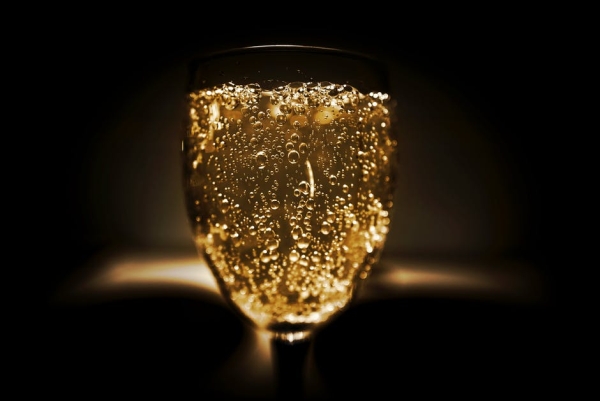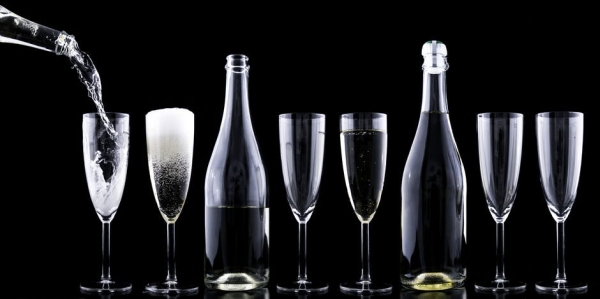The drink we enjoy today known as champagne has inspiring and surprising roots. It was first devised by a French widow in the early nineteenth century who almost went bankrupt in the process of creating and distributing it. The original champagne was actually extraordinarily sweet. It was practically twice as sweet as today’s sweet dessert wines because it contained about 300 grams of sugar. But declared as the only drink Tsar Alexander would drink, the popularity of champagne in Russia quickly propelled the widow Barbe-Nicole Clicquot to success. This fitted her with the opportunity to become the first modern businesswoman.
Champagne kind of feels like liquefied fairy dust in a flute. It’s a sparkling wine made from grapes harvested from the charming region of Champagne, France. You could drink it alone, with orange juice, or mix it up with other goodies and make it into a gorgeous cocktail. While it could be saved for special occasions, champagne also tastes awesome at other daily occasions. Like getting off work early. Or having the house to yourself on a quiet afternoon. Because what’s wrong with treating yourself?
But to get down to the nitty and gritty of champagne, there is some basic information about this wondrous drink that must be shared. What is the alcohol percentage of champagne exactly? How do they make champagne anyways? How do they make other sorts of sparkling wine? The answers shall all be revealed below in due time below.

Does Champagne Have Alcohol?
Deceptively, champagne could seem like an innocent drink which is relatively low in alcohol content. However, that is simply not the case. Just like wine, champagne definitely has alcohol. But how much alcohol does it have? That’s an interesting question.
How Much Alcohol Is In Champagne?
Based on an article published on Wine Intro, champagne alcohol content varies. Overall, a bottle of champagne will have alcohol content around 12.5%. But again, the alcohol content of champagne varies. It depends entirely on the bottle. Different types and labels could be prone to implement higher or lower alcohol content within their product.

Champagne Alcohol Percentage
Amongst many champagne labels, the range of alcohol percentage seems to rest between 11.5% and 12.5%. Compared to some various white wine labels, the popular Sutter Home White Zinfandel is 10%. Slightly lower on the percentage scale would be Dr Loosen Riesling which is just 7.5%. So the alcohol content in champagne is usually a bit higher than other similar light wines. But is it really that much of a difference? The numbers may be quite close, but the way the two wines are made will actually have a bit of a difference on the consumer. These differences will be discussed shortly.
Champagne Alcohol Proof
Originally, alcohol proof was coined in the United Kingdom. It measured the level of alcohol in an alcoholic drink. Back in those days, alcohol proof was roughly equal to 1.75 times the alcohol by volume (ABV). According to legend, the first concept of “proof” dates back to the 18th century. As the story goes, soldiers in the British Royal Navy had to drench their gunpowder in rum in order to rest the alcohol’s potency. If the soggy gunpowder was still able to catch flame, it was “proof” of the high alcohol content (about 57% ABV). Another legend suggests that the rum had to be at proof in case the jostling on ship caused the rum barrels to break open over the gunpowder, the gunpowder would still be useful.
Regardless of the origins, the United States adopted the proof method in the mid 19th century. That’s when it became somewhat altered. Rather than proof being about equal to 1.75 the ABV, the new standard settled on making 50% alcohol exactly “100 proof”.
With that measurement in mind, most champagnes would be between 23 and 25 proof. Although, typically alcohol proof is reserved for liquor with higher percentages of alcohol by volume.
What’s the Difference Between Champagne, Sparkling Wine, and Prosecco?
Champagne was first a province in France before also being tied to a popular alcoholic beverage. In order to be marketed as champagne, this drink must be created in the area of Champagne, France. If it is not, it is marketed as sparkling wine. Both undergo a second fermentation as well as riddling (a method also originally devised by Barbe-Nicole Clicquot).
Sparkling wine and champagne are essentially identical in all but name. They even use most of the same grapes in the process. Sparkling wines tend to incorporate Chardonnay, Pinot Noir, Pinot Blanc, and Pinot Meunier grapes. Champagne use Chardonnay, Pinot Noir, and Pinot Meunier grapes.
Because champagne is so popular, many vineyards around the world have come to adopt the same methods of creating the special drink. But if you look on a menu at a classy restaurant, you’ll be able to immediately distinguish whether a sparkling wine was made in Champagne or not. If it is called champagne, rest easy that the drink arrived from France. If it is referred to as sparkling wine, the quality could be just as good. However, it was not made in Champagne. It’s a simple enough distinction to be made.
Prosecco is made in the Veneto region of Italy, just north of Venice. While the most obvious difference between champagne and prosecco is that the former comes from France while the latter is from Italy, there are a few other minor separations. While other sparkling wines use the expensive “Traditional Method”, prosecco uses the “Tank Method”.
Prosecco tends to be a bit sweeter than champagne. It’s also less yeasty and slightly gentler. Another notable difference is that prosecco is available at a much lower price than champagne. While champagne continues the fermentation process within the bottle, prosecco will become stale after a while.
How Do They Make Sparkling Rosé and Pink Champagne?
Each wine has its own standards of creation. There are certain rules to be followed. With sparkling rosé wine, it can only be created in the region of Champagne, France. It’s the only place in the world where winemakers are allowed to mix red and white wine together in order to create a rosé. And that is how they make pink champagne.
Using the same process of second fermentation, still red wine is added to the sparkling wine. Winemakers usually use about 15% of a red wine to blend with the sparkling wine. This gives it a faint red color. It also makes rosé a bit stronger than a normal champagne, due to the red wine added in.
The other way that sparkling rosé wine is made is by the saignée method. “Saignée” literally translates to “bleeding”. With this method, that’s basically what the grape skins are doing for the juice. It’s a winemaking process used around the world to create still rosé wines. It requires minimal grape skin contact for a couple hours. The minimal maceration deepens the color and develops stronger flavor profiles as well as aromas.
If you want to know how to best choose a champagne, you’ll want to know the difference between these three. It’s always good to try something new, though. So even if you’re unfamiliar with the taste and body of either of these sparkling wines, it’s a good plan to just grab a bottle after looking up some reviews online.
How Many Glasses Are In A Bottle Of champagne?
In a standard 750ml bottle of champagne, there are around 5- 6 full glasses able to be poured. A standard bottle of wine averages about five glasses. You get more out of a bottle of champagne due to the size and shape of the flutes as well as the bubbles arising from the sparkling wine. So when you’re planning a nice dinner party for guests, make sure you keep in mind this number. Be sure to grab as many bottles as you need of sparkling wine or champagne.
Additionally, if you were wondering how many ounces are in a glass of champagne, this answer varies. At restaurants, you’ll typically be served about four ounces per flute. At home, you could go from 5 – 6 ounces a pour. This measurement will also factor into how many glasses you’ll be able to get out of a bottle of champagne.

Does Champagne Get You Drunk Faster?
Blood alcohol levels can definitely rise faster if you’re drinking champagne, according to research posted on BBC News. The reason for this is actually the bubbles in champagne. The bubbles and gas cause the alcohol to hit the bloodstream faster than a glass of still wine would. It also hits the stomach faster. If someone is sipping on too much champagne in one sitting, they’ll definitely begin to feel a little tipsy before they know it.
And that giddy feeling that starts to accompany the downing of the champagne flutes? Rapid alcohol absorption can speed up the stimulation of being intoxicated. When the alcohol hits the bloodstream, you’re going to feel it.
Because of this, it’s even more important to take it easy when you’re enjoying a nice glass of bubbly. Take slow sips off your flute and make it last. Try to stick to just one drink an hour in order to keep a clear head. To be even safer, limit your intake to just two or maybe three glasses of champagne.
How Much Champagne Does It Take To Get Drunk Or Reach A .08 BAC?
For wine and champagne, drinking a four-ounce glass of champagne is similar to taking a shot of liquor. But again, although people may take longer to attend to their champagne flute, sparkling wine will hit the bloodstream a lot faster than liquor. It’s important to space out your drinks so as not to overdo yourself.
In order to calculate the exact blood alcohol content (BAC) you’ve attained, there’s a handy BAC calculator readily at your disposal. From this calculator, it was easy to find out that an average-sized woman who has been partying for the past three hours and imbibed 16 ounces of champagne will accrue a 0.079 BAC. This is just under the legal limit. However, there are a lot of important factors to consider.
A person’s emotional and mental state could easily sway the BAC. Someone who is distressed might be more susceptible to becoming drunk faster than other individuals with positive mindsets. Metabolism, body type, and physical health can also affect blood alcohol content. If someone hasn’t had a full meal recently, it could be another factor to causing quicker alcohol absorption. If the drinks a person is having are stronger than normal, it’ll also promote more immediate inebriation. Lastly, it’s important to be aware of what sort of medication you’re on when you choose to drink. Be certain that alcohol will not negatively impact you due to any medication.
A good plan would be to stick to the “one drink per hour” rule. Because it can be difficult to pinpoint exactly how much alcohol you’ve drunk and which factors could affect your blood alcohol content, it’s best to not fully rely on calculators. They’re great for an overall picture, but not a fully reliable source when it comes to each individual’s BAC.
Champagne is a great drink. It’s versatile and can go with many meals, parties, and occasions. It has a wonderful aesthetic and is enjoyed by many people the world over. But it’s crucial to remember not to drink too much of it, regardless of how tempting that may be. If you’ve been arrested or cited for DUI after imbibing too much bubbly, contact a qualified and experienced Oregon DUI defense attorney immediately.
